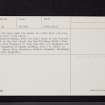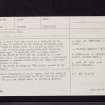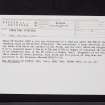Scheduled Maintenance
Please be advised that this website will undergo scheduled maintenance on the following dates: •
Tuesday 3rd December 11:00-15:00
During these times, some services may be temporarily unavailable. We apologise for any inconvenience this may cause.
North Port O'spittal
Inhumation (Bronze Age), Short Cist (Bronze Age), Cinerary Urn (Pottery)(Bronze Age), Food Vessel (Pottery)(Bronze Age)
Site Name North Port O'spittal
Classification Inhumation (Bronze Age), Short Cist (Bronze Age), Cinerary Urn (Pottery)(Bronze Age), Food Vessel (Pottery)(Bronze Age)
Canmore ID 60612
Site Number NX05SW 11
NGR NX 0277 5240
Datum OSGB36 - NGR
Permalink http://canmore.org.uk/site/60612
- Council Dumfries And Galloway
- Parish Stoneykirk
- Former Region Dumfries And Galloway
- Former District Wigtown
- Former County Wigtownshire
NX05SW 11 0277 5240.
In 1899, a short cist was found in a sand-pit on the farm of Port of Spittal on the sloping south-east side of the field in which there is a standing stone (NX05SW 2), and in which many grave-slabs were turned up many years ago. It measured 3'9" in length with a breadth and depth of 2'6" and was covered by a large whinstone slab. It contained a food vessel, irretrievably smashed, a jawbone containing nine teeth and other small pieces of bone.
Locally the field is known as "The burial ground of the four Kings." (see also ONB entry attached to NX05SW 2).
F R Coles 1900; L M Mann 1915; D D A Simpson 1965; Galloway Gazette 5 November 1899
From ground inspection it would appear that the sand-pit is the "gravel-pit" published on OS 25" plan at NX 0277 5240. The pit, no longer used, is partially grassed over, and lying near its centre is a flat slab 1.0m long x 0.6m wide x 0.1m thick.
In Stranraer Museum, from the field known as the 'burial ground of the four Kings' are the following finds - Nine teeth, five fragments of long bone with urn fragments and three fragments of coarse pottery, from a BA burial in 1899. Donor, Miss Robertson, Mardale Crescent, Edinburgh. (Acc. Nos: 1954/3+4).
Visited by OS (WDJ) 1 September 1970
About 29 October 1899 a cist was discovered in a sand pit about 70m ESE of the standing stone at North Port O'Spittal. The coverstone, a large whinstone slab, lay about 0.9m below the surface of the field, and the cist, which was aligned from E to W, measured about 1.15m by 0.75m and 0.75m in depth; it contained the remains of an inhumation and, in the SE corner, a broken 'urn'. Fragments of the urn, three sherds of coarse pottery, nine teeth and five pieces of long bone are preserved in the Stranraer Museum (1954/3 and 4).
The Antiquary 1899; F R Coles 1900; RCAHMS 1985














